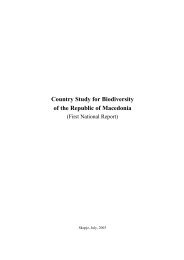CBD Fourth National Report - Azerbaijan (English version)
CBD Fourth National Report - Azerbaijan (English version)
CBD Fourth National Report - Azerbaijan (English version)
Create successful ePaper yourself
Turn your PDF publications into a flip-book with our unique Google optimized e-Paper software.
Country Study on Biodiversity and <strong>Fourth</strong> <strong>National</strong> <strong>Report</strong><br />
The Republic of <strong>Azerbaijan</strong><br />
Cow-parsnip Heracleum trachyloma Leaves and stem are eaten.<br />
Sorrel Rumex spp. Leaves and stem are used<br />
Caper Capparis herlacea Buds are pickled<br />
Sugar cane Sorghum saccharatum Used to produce syrup and doshab (boiled<br />
down fruit juice)<br />
Cockspur Echinochloa crusgalli Nutritional uses (America)<br />
American Millet Milium effusum Seeds are used in baking bread<br />
Chervil Chaerophyllum aureum Seeds are used as fodder for domestic animals<br />
and poultry<br />
Timber<br />
Around 400 species of trees and bushes are recorded in <strong>Azerbaijan</strong> (representing nearly 10%<br />
of the country’s flora) and approximately 11% of the land area is forested. Timber provides a<br />
source of materials for construction and furniture making. Key timber species include<br />
hornbeam (Caprinus spp.), Georgian oak (Quercus iberica) and beech (Fagus spp.). Since<br />
2005 it was prohibited by the MENR to use forest materials as a firewood.<br />
Medicinal plants<br />
Around 800 plant species of medicinal value have been recorded in <strong>Azerbaijan</strong>, including 150<br />
species used in pharmacology. Key medicinal plants include elecampagne (Inula helenium),<br />
origanum (Origanum vulgare), coltsfoot (Tussilago farfara), valerian (Valeriana officinalis),<br />
and Helychrisum arenarium, with 33 dried products obtained from these plants, which are<br />
mainly traded by “Azerfarm Ltd”. In addition a range of oil-based products are developed<br />
through cold pressing of various plants (including various nuts and fruits), and a traditional<br />
medicine called doshab (a concentrated syrup, usually of mulberry) is produced from a range<br />
of wild plants, including mulberries, medlar and rosehips. Currently there is a growing<br />
recognition of the importance of extending the cultivation of medicinal plants, and moves<br />
towards certification is necessary to broaden the access to European markets.<br />
Plants in foreign trade<br />
A number of plants from <strong>Azerbaijan</strong> have attracted foreign businessmen, and some valuable<br />
plants are exported abroad, including cultivated liquorice (Glycyrrhiza glabra), linden (Tilia<br />
cordata), cane (Phragmites australis), reed (Arundo donax) and nettle (Urtica dioica).<br />
Export of plants to foreign countries is regulated under relevant permits (licences) issued by<br />
proper authorities.<br />
The population of the Nakhichevan Autonomous Republic use wild plants for medicinal,<br />
food, wood, dyes and other purposes. Many of the species collected are rare, endemic or<br />
endangered. A great number of plants (up to 750 species) are used in traditional remedies and<br />
medicines, and resources of Nakhichevan can be seen as a ‘natural pharmacy’. The level of<br />
collection of some natural products is relatively extensive. 29 A few of these are currently<br />
commercially cultivated (by the “Scientific-Production Co-operative for Medical Plants”, and<br />
further expansion of cultivation may be an option in future.<br />
29 Figures for 1988 indicate production as follows: rose hips (83 tonnes), hawthorn (82 tonnes), wild<br />
apples and pears (157 tonnes) and thyme (56 tonnes).<br />
76<br />
2009

















